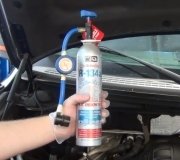What is the history that led up to this? If this all started with a leak, and no pressure in the system, the standard procedure is to add some refrigerant, then use an electronic leak sniffer to search for the leak. Common locations are the crimp fittings on the ends of the rubber hoses, the seal behind the clutch on the compressor, the bottom of the condenser, and the evaporator. Find an evaporator leak by sniffing at the condensate drain tube in front of the firewall. Usually you will also see oil stains in the area of the leak, especially at the ends of hoses.
You can also inject some dye before charging the system. That takes longer to show up, but you find the leak by searching with a black light a day or two later. The dye will show up as a bright yellow stain that you can follow back to the source of the leak.
You could also still have some moisture in the system. The whole purpose of pumping the system into a vacuum is the extremely harmful moisture boils at 77 degrees in a vacuum, then it is easier to suck out. The way to identify if there is still moisture in the system is to let it sit for a few minutes under vacuum. If water is still vaporizing and expanding, you will see the vacuum being slowly lost on the low-side gauge, just like you described. That is why we need to know the history. If the car came in with no pressure, there is a leak that needs to be fixed. If the system had a charge but a part needed to be replaced, there likely was and is no leak, and you just need to pull a vacuum for a longer period of time. The industry standard used to be to maintain the vacuum for an hour, but most people have cut that back to a half hour.
SPONSORED LINKS
Thursday, April 20th, 2017 AT 4:28 PM




